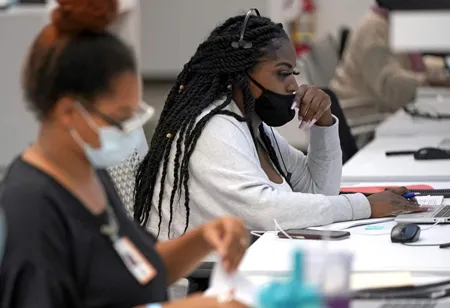THANK YOU FOR SUBSCRIBING
Be first to read the latest tech news, Industry Leader's Insights, and CIO interviews of medium and large enterprises exclusively from Gov CIO Outlook
THANK YOU FOR SUBSCRIBING

By
Government CIO Outlook | Tuesday, August 24, 2021
Stay ahead of the industry with exclusive feature stories on the top companies, expert insights and the latest news delivered straight to your inbox. Subscribe today.
Digital contact tracing is more scalable than manual contact tracing, with the ability to identify contacts that would be impossible to track manually, such as encounters with strangers on public transportation or in a coffee shop.
FREMONT, CA: Digital contact tracing is a system through which cell phones exchange information about close connections with other smartphones running the same contact tracing software.
IoT-enabled digital contact tracing
The Internet of Things (IoT) is a global network of computing devices that can exchange data without human or computer input. The number of infected cases increases every day with the present pandemic, making physical contact tracing impossible.
[vendor_logo_first]
Digital contact tracking detects contacts made when a person comes into contact with an infected person. This can be done via a GPS or Bluetooth signal. The risk of infection depends on the person's proximity (less than 1 m) and the duration of the interaction. Due to obstructions such as a wall or being enclosed in personal protective equipment, proximity tracking cannot provide a thorough assessment of infected person interactions. The Internet of Things can create a scalable, automated contact tracing system capable of handling the growing strain of contact tracking.
Numerous contact tracing frameworks have been designed to comply with regional privacy and security legislation. These solutions use sensors to identify the user's close connections or track their position (tracking solutions). These apps need special permissions or sensory input to warn users about malware threats. Google's COVID-19 Community Mobility Reports and Apple's COVID-19 Mobility Trends Reports anonymously aggregate data from millions of users. People and crowds are tracked to identify hotspots and, most significantly, to measure the effectiveness of lockdowns in various locations and countries. These apps are for healthy people who want to know their risk of infection if they meet someone with COVID-19. By anticipating transportation data, these digital contact tracking solutions can control passenger flow in passenger waiting rooms.
Other aggressive approaches to geofence individuals in quarantine through dedicated smartphone applications or more convenient engagement by phone call or text message. This implementation is required, and resistance is a felony. BubbleBox is a new platform that combines integrated IoT devices and software to contain and identify future COVID-19 infection outbreaks. BubbleBox, a wristband-based device, keeps track of contacts. Users can report issues and identify their devices via a web application. They allow authorized medical personnel to quickly assess the spread of infection, track who needs to be tested, and contact patients. Finally, the anonymized data collected can be used to discern trends in the infection's spread.
Usability is also essential for improving system usage and hence contact tracing coverage. Finally, as contact tracing applications and systems grow widespread, they will only be effective if they are interoperable. As a result, a standard for data collection is required.
IoT is a cutting-edge technology that allows for continuous monitoring of high-risk patients.
I agree We use cookies on this website to enhance your user experience. By clicking any link on this page you are giving your consent for us to set cookies. More info

However, if you would like to share the information in this article, you may use the link below:
www.govciooutlookapac.com/news/contact-tracing-using-the-internet-of-things-nid-1401.html



